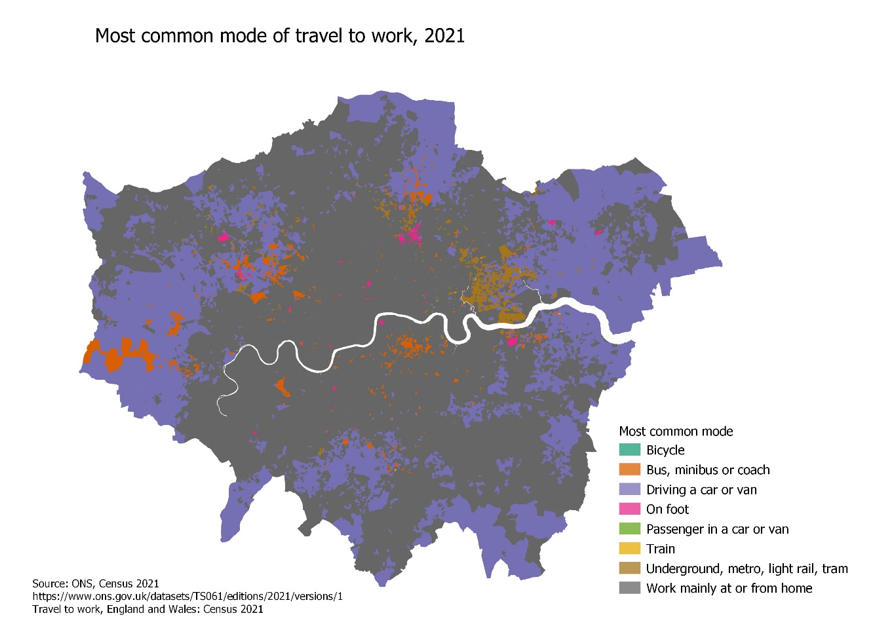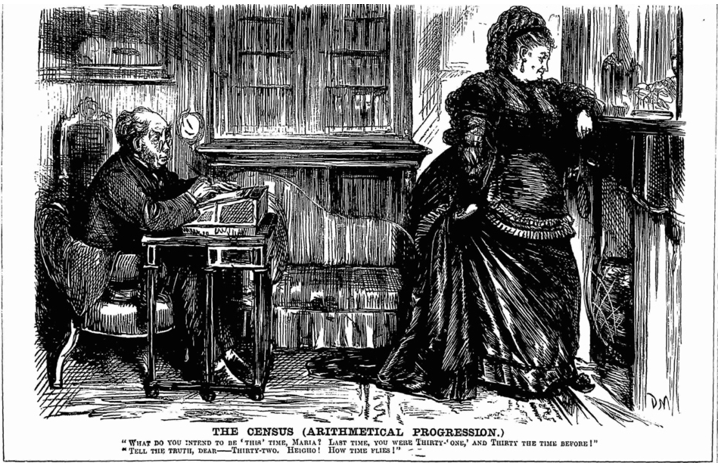 Oliver Duke-Williams introduces the UK Statistics Authority’s recommendation on the future of the 2031 UK censuses.
Oliver Duke-Williams introduces the UK Statistics Authority’s recommendation on the future of the 2031 UK censuses.
The UK Statistics Authority has today made a recommendation that a full digital-first census is conducted in England and Wales in 2031.
Similar recommendations have been made and published today by the Northern Ireland Statistics and Research Agency (NISRA) and by National Records of Scotland (NRS) that a full census is held in 2031.
The respective governments have the final decision about whether these recommendations are accepted.

If the recommendations are accepted, these censuses will form the latest in series that started in 1801.
The UK Data Service make available data from ‘modern’ censuses (roughly, 1961 onwards) and provides access to historic data (1851-1921) curated by the I-CeM (Integrated Census Microdata) project. Longitudinal data are available through CeLSIUS (Centre for Longitudinal Study Information & User Support), NILS-RSU (Northern Ireland Longitudinal Study Research Support Unit) and SLS-DSU (Scottish Longitudinal Study Development & Support Unit).
Some questions have remained as part of the census throughout (or at least, at an individual level, since 1841), and have invariably inspired the same themes in cartoonists for over a century.
“The Census (Arithmetical Progression)” – George du Maurier, Punch, 1871 via Gale
Consultation on an admin data-focused approach
In June 2023, ONS launched a consultation on proposals on the future of population and migration data and they reported on the results of this in December 2023.
The proposals set out an ambitious plan, for a “system [that] would primarily use administrative data like tax, benefit and border data, complemented by survey data and a wider range of data sources”, which would remove the need for a decennial census.
This reflected a view voiced by government in 2014 that after 2021 censuses should be conducted using administrative and other data sources rather than a traditional household schedule .
UK Data Service and CeLSIUS were amongst many organisations which responded to the consultation, identifying both the exciting potential of the proposals and the concerns raised by census data users about limitations of admin data.
Advantages of the use of admin data include much greater timeliness of outputs, and reduced data capture costs: these are data that are already collected as part of administrative processes – in education, in health care, and in tax and benefits, for example – although there would still be significant costs re processing them for re-use to form population estimates.
On the other hand, many existing census users are concerned that some aspects of data would be difficult to replicate, especially for detailed classifications and/or for small spatial areas. ONS have done much development work, and have demonstrated progress in producing population estimates, although it is clear that further work will be required to satisfy some groups of users.
One of the key difficulties in creating an “admin census” is linkage of records between different sources.
In the UK we do not have a single comprehensive ID number (and creating one would be a major political issue) – but rather we have a number of ID values such as NHS numbers, National Insurance numbers, Unique Learner Numbers and so on, with a range of overlaps and each with their own peculiarities.
In most if not all admin systems, there are simultaneously problems with both under-count and over-count: under-count relates to people who should be ‘in the system’ but for some reason are not, and over-count occurs when a person is present more than once (often because they have records at different addresses).
Resolving these difficulties to produce a ‘correct’ list of individuals is a far from easy task.
In January 2025, I was asked to join a panel discussion at the first UK Statistics Assembly, on the future of population and migration data, and talked about possible acceptance criteria and considerations that might be needed if there was to be a switch from a traditional census to one primarily based on admin data. Census data and the implications of possible change were mentioned and discussed in several parallel sessions as well.
The session was well attended both in person and online, and two things were clear – firstly that many users of census data were worried about future research, and secondly that ONS had been listening to the concerns of users raised as part of the consultation process.
Looking forward
So, if we are to have a full census in 2031, what will that mean?
The 2021 Census took place during the Covid-19 pandemic (and in Scotland, was moved to 2022), which had various effects on the data collected. Many people were furloughed or had left employment, and many others were working from home; many students had returned to a parental address rather than living at their planned term-time address.
This has led to results, especially related to work, being unrepresentative of the state of the nation immediately before, and a few years after the pandemic. This map shows the extraordinary dominance of ‘work mainly at or from home’ as the most commonly state mode of travel to work, in London in 2021, with car driving featuring as the main alternative in outer London.

On the other hand, response rates in England and Wales and in Northern Ireland were good, perhaps because people had more time at home, and had spent a year engaging with online processes for education, health, work and other parts of their lives.
It is of course to be hoped that no such events occur in 2031, and a much more representative census can be delivered. One of the interesting things will be to compare how much the much-touted “new normal” of 2021 has reverted to pre-2021 normality.
How would a new map of most common mode of travel compare to the one below, and can we learn anything that will help to promote the use of active travel and public transport?
Will it tell us anything about those who want to work from home, and about those who do, but might not wish to do so. From this perspective, the 2021 Census was a significant social document of a society in the middle of a pandemic.
‘Digital first’
A ‘digital-first’ census is one primarily collected online, as was the case in 2021. There will remain some ‘hard to enumerate online’ groups, and ONS, NISRA and NRS will no doubt be thinking about these.
Ideas that were discussed prior to the 2021 Census (and prior to the pandemic) included the use of local libraries to help collect data, and perhaps these ideas will be revived.
ONS will have learned many lessons from 2021, and can repeat the workflows developed and introduced then – one of the hoped for advantages of a digital-first census is that primary data are delivered much sooner than is the case with a primarily paper based operation.
Developing the set of questions
Three questions that were introduced in the 2021 Census (and in parts in the 2021 Census in Northern Ireland and in the 2022 Census in Scotland) explored sexual orientation, gender identity and veteran status. If these questions are repeated (or if there are updated questions on the same themes), then the 2031 Census will offer the first opportunity to see how these things are changing (or remaining stable) in society.
These are good examples of questions relating to small population groups:
- less than 5% of the population in the case of gay or lesbian, bisexual or other sexual orientations,
- also less than 5% in the case of Armed Forces veterans,
- less than 1% in the case of people who reported that their gender identity was different from their sex at birth.
Censuses can deliver large enough numbers to look at detailed characteristics, or at small spatial areas.
In turn, the 2031 Census will also offer a third observation of questions first asked in 2011 (for example, main language used), allowing the opportunity to compare decadal change.
It will also see the ONS Longitudinal Study – which samples approximately 1% of the population of England and Wales extend its coverage to 60 years (1971-2031), with most of those included in the first wave having completed or approaching the completion of their working lives.
Will we have new questions in 2031? There will of course by those who make the case for additional questions, whilst on the other hand there will be pressure to reduce respondent burden.
New and additional questions are trialled before each census; income is one such question that has been tested many times – there is clear user demand, but this is balanced by concerns that it might reduce response rates.
There may be pressure to modify existing questions, although that then makes change-over-time comparisons difficult.
It might be argued, for example, that questions about work don’t accommodate well the situation for many people who have multiple jobs in different locations and for different employers, but for who it is difficult to identify a ‘main job’.
However, a census can only ask a limited number of questions, and generally have to compromise on detail.
Suggestions for new questions?
The UK Data Service held its 2025 UK Census User Conference last week, and during wrapping up we asked the audience (without promising to deliver!) about new questions they would like to add to the census, with the ability for audience to signal approval of suggestions.
The highest voted five are shown below; what would be your question?
| Rank | Question |
| 1 | How happy are you? |
| 2 | On working (office, home, hybrid) |
| 3 | Specific health conditions (esp. mental health, depression and anxiety, neurodiversity, chronic illness) |
| =4 | Wellbeing |
| =4 | Free text response for “time capsule” |
These responses are interesting: the question on happiness (and perhaps on wellbeing) is an attitudinal one, and has similarities to the existing question “How is your health in general?” – it has to be self-completed.
In contrast, whilst questions on specific health conditions can be included in a census, and are included in Scotland and in Northern Ireland, they are also well suited to being explored via administrative data on primary care, hospital treatment and prescription data: a strong case for admin data.
The question on working patterns reflect the fact that the census (or any other data collection) needs to be able to adapt to changes in societal behaviour.
Finally, the ‘time capsule’ question draws focus to another important aspect of the census: to document the nation and provide evidence to future historians and genealogists. A free text question was included in the Census of Ireland 2022, and was viewed with interest by many census professionals and researchers.
Future of the UK Demographic System
The UK Data Service is pleased to be joining with colleagues at the British Society for Population Studies, CeLSIUS and ONS to take part in a day meeting on the Future of the UK Demographic System, to be held in London at UCL, on July 10th 2025.
We will be discussing the implications of this recommendation, and looking forward to the future.
The meeting will be hybrid, and we look forward to you joining us online or in person.
About the author
Oliver Duke-Williams is Professor of Population Information at the UCL Department of Information Studies, and teaches on the MA/MSc Digital Humanities programmes there.
He is Census Service Director at the UK Data Service, and a senior advisor in the Centre for Longitudinal Study Information and User Support (CeLSIUS).
Oliver is a member of the National Statistician’s Methodological Assurance Review Panel. MARP was originally set up in 2018 to undertake a review of methods and research associated with the 2021 Census, and the recommendation about the future of population statistics.
This blog post is written from the perspective of UK Data Service and CeLSIUS as facilitators of access to data for the research community.
Comment or question about this blog post?
Please email us!

